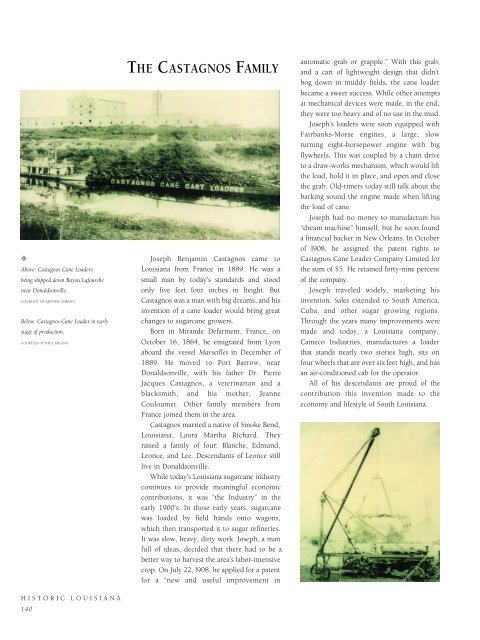Historic Louisiana
An illustrated history of Louisiana, paired with the histories of companies, families and organizations that make the state great.
An illustrated history of Louisiana, paired with the histories of companies, families and organizations that make the state great.
You also want an ePaper? Increase the reach of your titles
YUMPU automatically turns print PDFs into web optimized ePapers that Google loves.
✧<br />
Above: Castagnos Cane Loaders<br />
being shipped down Bayou Lafourche<br />
near Donaldsonville.<br />
COURTESY OF ARTHUR LEMANN .<br />
Below: Castagnos Cane Loader in early<br />
stage of production.<br />
COURTESY OF PAUL MILANO.<br />
HISTORIC LOUISIANA<br />
140<br />
THE CASTAGNOS FAMILY<br />
Joseph Benjamin Castagnos came to<br />
<strong>Louisiana</strong> from France in 1889. He was a<br />
small man by today’s standards and stood<br />
only five feet four inches in height. But<br />
Castagnos was a man with big dreams, and his<br />
invention of a cane loader would bring great<br />
changes to sugarcane growers.<br />
Born in Mirande Defarment, France, on<br />
October 16, 1864, he emigrated from Lyon<br />
aboard the vessel Marseilles in December of<br />
1889. He moved to Port Barrow, near<br />
Donaldsonville, with his father Dr. Pierre<br />
Jacques Castagnos, a veterinarian and a<br />
blacksmith, and his mother, Jeanne<br />
Couloumet. Other family members from<br />
France joined them in the area.<br />
Castagnos married a native of Smoke Bend,<br />
<strong>Louisiana</strong>, Laura Martha Richard. They<br />
raised a family of four: Blanche, Edmund,<br />
Leonce, and Lee. Descendants of Leonce still<br />
live in Donaldsonville.<br />
While today’s <strong>Louisiana</strong> sugarcane industry<br />
continues to provide meaningful economic<br />
contributions, it was “the Industry” in the<br />
early 1900’s. In those early years, sugarcane<br />
was loaded by field hands onto wagons,<br />
which then transported it to sugar refineries.<br />
It was slow, heavy, dirty work. Joseph, a man<br />
full of ideas, decided that there had to be a<br />
better way to harvest the area’s labor-intensive<br />
crop. On July 22, l908, he applied for a patent<br />
for a “new and useful improvement in<br />
automatic grab or grapple.” With this grab,<br />
and a cart of lightweight design that didn’t<br />
bog down in muddy fields, the cane loader<br />
became a sweet success. While other attempts<br />
at mechanical devices were made, in the end,<br />
they were too heavy and of no use in the mud.<br />
Joseph’s loaders were soon equipped with<br />
Fairbanks-Morse engines, a large, slow<br />
turning eight-horsepower engine with big<br />
flywheels. This was coupled by a chain drive<br />
to a draw-works mechanism, which would lift<br />
the load, hold it in place, and open and close<br />
the grab. Old-timers today still talk about the<br />
barking sound the engine made when lifting<br />
the load of cane.<br />
Joseph had no money to manufacture his<br />
“dream machine” himself, but he soon found<br />
a financial backer in New Orleans. In October<br />
of l908, he assigned the patent rights to<br />
Castagnos Cane Loader Company Limited for<br />
the sum of $5. He retained forty-nine percent<br />
of the company.<br />
Joseph traveled widely, marketing his<br />
invention. Sales extended to South America,<br />
Cuba, and other sugar growing regions.<br />
Through the years many improvements were<br />
made and today, a <strong>Louisiana</strong> company,<br />
Cameco Industries, manufactures a loader<br />
that stands nearly two stories high, sits on<br />
four wheels that are over six feet high, and has<br />
an air-conditioned cab for the operator.<br />
All of his descendants are proud of the<br />
contribution this invention made to the<br />
economy and lifestyle of South <strong>Louisiana</strong>.
















